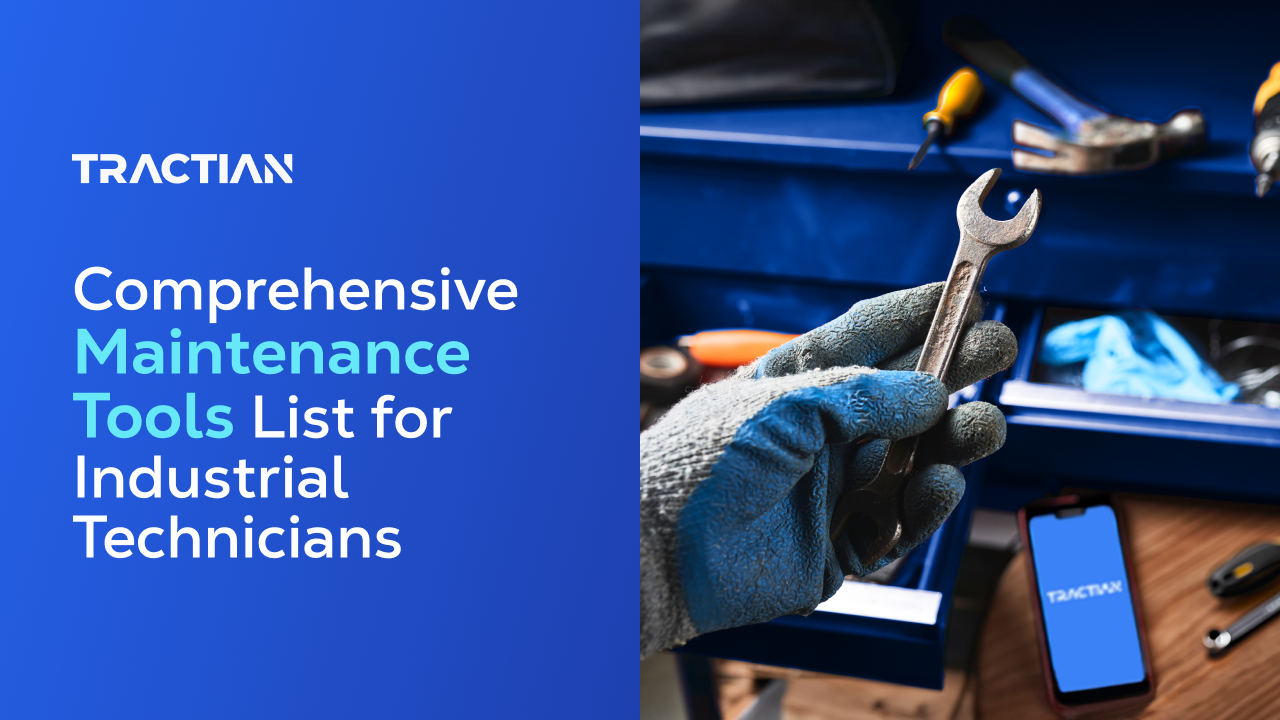Have you ever wondered how crucial tools are to a maintenance technician’s success? In industrial operations, the effectiveness of maintenance work hinges significantly on the maintenance tools list.
The deal is: maintenance is vital to prevent costly downtimes and extend equipment lifespan. But, without the right tools, even the most skilled technicians can struggle, leading to inefficiencies and potential failures.
Conversely, equipped with a comprehensive toolkit, they can enhance productivity and ensure seamless operations.
This article delves into the essential tools every industrial technician should have, showcasing how the right equipment can make all the difference in maintaining optimal performance.
Essential Maintenance Tools
1. Multimeter
A multimeter is your go-to for checking out electrical systems. It can measure voltage, current, and resistance, letting you diagnose problems quickly and accurately.
It’s like a translator for the electrical world - it helps you understand what’s going on under the hood.
Remember, calibration is key to keeping your readings reliable, so don’t skip that step.
When choosing a multimeter, resist the urge to go for the cheapest option. A high-quality, dependable one will be your best friend on the job.
2. Screwdriver Set
A comprehensive screwdriver set is a fundamental building block of any technician’s toolkit.
These trusty tools come in various styles, including flathead, Phillips, and Torx, each designed to tackle specific screw types.

Investing in magnetic screwdrivers is a wise move, as they prevent screws from becoming lost in complex machinery, saving you time and frustration.
So, having a versatile set is crucial for both routine maintenance tasks and emergency repairs, allowing you to tackle a wide range of challenges with confidence.
3. Wrenches
Wrenches are the go-to tools for tightening and loosening nuts and bolts, making them an absolute staple in your maintenance tools list.
There are different types to suit various needs, including adjustable wrenches, socket wrenches, and Allen wrenches.

Adjustable wrenches offer flexibility for working with different bolt sizes, while socket wrenches provide greater torque and facilitating conditions while working in tight spaces.
Allen wrenches, also known as hex keys, are essential for tackling machinery that uses hexagonal socket screws.
Having a set that includes both metric and imperial sizes ensures you’re prepared for whatever equipment comes your way, allowing you to handle any maintenance task with ease.
4. Flashlight
A durable, high-powered flashlight might not be the first tool you grab, but it’s undeniably important.
Inspecting hard-to-reach areas and working in low-light conditions become much more manageable with a reliable flashlight in your hand.
LED flashlights are a popular choice for their energy efficiency and extended battery life. They provide a bright, consistent light source, crucial for identifying potential issues that might otherwise be hidden in the shadows.
Having a flashlight ready for action can make a significant difference in both routine checks and emergency situations.
Essential Personal Protective Equipment (PPE)
5. Safety Goggles
Safety goggles are the frontline defense for your eyes, protecting them from debris, chemical splashes, and dust that can arise during maintenance work.
They act as a barrier against these hazards, preventing serious eye injuries.
To maximize both protection and comfort, consider using anti-fog and scratch-resistant goggles.
These features ensure clear visibility and extended durability, allowing you to work effectively in various environments without worrying about constant cleaning or replacements.
6. Gloves
Gloves are vital for safeguarding your hands from cuts, abrasions, and chemical exposure. To put it simply, it’s a must on your maintenance tools lis.
There’s no one-size-fits-all solution, so different types of gloves are designed for specific tasks:
- Nitrile Gloves: These offer ideal protection against chemicals and punctures.
- Latex Gloves: Commonly used for general-purpose tasks, but be cautious if you have latex allergies.
- Leather Gloves: Excellent for handling sharp objects or heavy machinery, providing superior protection against cuts and abrasions.
- Insulated Gloves: Absolutely essential when working with electrical components to prevent electric shock.
7. Hearing Protectors
Hearing protectors are crucial for preventing hearing damage in noisy environments.
Prolonged exposure to loud noises can lead to permanent hearing loss, so using appropriate hearing protection is vital.
Here are your options:
- Earmuffs: Providing a comfortable fit and excellent noise reduction, earmuffs are ideal for situations requiring extended use.
- Earplugs: Compact and effective, earplugs are a good choice when earmuffs might be impractical.
Remember, ensure your chosen hearing protectors meet OSHA standards for noise reduction to guarantee adequate protection for your ears.
But how can you know if a work environment is too noisy? You need to measure the noise levels. Here’s how:
- Sound Level Meter: A handheld device that measures sound pressure levels in decibels (dB). Simply point it in the direction of the noise source and read the displayed measurement.
- Dosimeter: A wearable device that measures cumulative noise exposure over time. Technicians can wear it throughout their shift to monitor the total noise exposure, ensuring it stays within safe limits.
- Mobile Apps: There are various smartphone apps available that can provide approximate noise level readings. While not as accurate as dedicated devices, they can be useful for quick, on-the-go assessments.
8. Additional Protections to Consider
While the items above are essential, there are other common PPEs that might be necessary depending on the task:
- Foot Protection: Steel-toed boots or shoes shield your feet from falling objects and compression injuries.
- Body Protection: Coveralls, aprons, or protective suits guard against chemical splashes, dirt, and contaminants.
- Respirators: Necessary when working in environments with airborne particles, gasses, or vapors that could be harmful if inhaled.
A safety engineer can assess your specific operational chain and processes to determine the exact PPE required for each task.
Remember, comprehensive protection is always the best approach.
Modern Tools Supercharging Maintenance Practices
9. IoT Sensors
IoT sensors are revolutionizing maintenance practices by providing a constant stream of data on machine health.
These sensors monitor critical parameters like temperature, vibration, noise, and energy consumption.
This real-time data plays a pivotal role in predicting equipment failures and facilitating preventive maintenance scheduling. The result? Reduced downtime and a significant boost in overall efficiency.
Energy Trac is a prime example of this technology.
It’s an EMS, offering a complete ecosystem to monitor your energy usage - including the sensors.
This way, it offers comprehensive energy monitoring and management, helping you optimize energy use, detect anomalies, and prevent equipment failures linked to energy issues.
By keeping a watchful eye on parameters like voltage, current and power factor, Energy Trac provides valuable insights that empower proactive maintenance, ensuring smooth and efficient operation of your machinery.
Smart Trac is another powerhouse tool that significantly enhances maintenance practices.
It boasts features like real-time monitoring of machine vibrations and temperatures, coupled with advanced algorithms that predict potential failures.
This predictive capability empowers maintenance teams to address issues before they snowball, minimizing downtime and extending equipment lifespan.
For maintainers, Smart Trac translates to data-driven decisions, while for companies, it means smoother production schedules with fewer interruptions.
10. CMMS
A Computerized Maintenance Management System (CMMS) is an essential cog in the machinery of modern maintenance operations - and a must in your maintenance tools list.
This software offers a comprehensive suite of capabilities, from managing maintenance schedules and tracking work orders to storing historical data on equipment performance.
By streamlining maintenance workflows, improving communication among teams, and boosting overall productivity, a CMMS is a game-changer.
TracOS™ exemplifies an effective CMMS.
It seamlessly integrates into the daily routines of all factory floor personnel, from operators and technicians to managers and decision-makers.
Here’s a glimpse into its key features:
- Maintenance Scheduling: Automates the scheduling of preventive and predictive maintenance tasks, ensuring timely interventions and minimizing unplanned downtimes.
- Work Order Management: Provides real-time tracking of work order status, from creation to completion, fostering clear visibility and accountability.
- Data Storage and Analysis: Maintains comprehensive records of equipment performance, maintenance history, and other critical data, empowering detailed analysis and informed decision-making.
For operators, TracOS™ simplifies the process of reporting issues and accessing maintenance instructions. Technicians benefit from streamlined workflows and easy access to historical data, allowing them to perform repairs with greater efficiency.
Managers and decision-makers gain valuable insights into maintenance operations, helping them optimize resource allocation, reduce costs, and elevate overall plant performance.
The magic truly unfolds when you integrate IoT sensors like Energy Trac and Smart Trac with a robust CMMS like TracOS™.
This combination creates a highly efficient maintenance ecosystem. It not only enhances the accuracy and effectiveness of maintenance activities but also provides a significant competitive edge by ensuring maximum asset utilization and minimal downtime.
Conclusion
To keep you organized and your maintenance tools list in top shape, we’ve put together a comprehensive checklist.
Use this handy guide to regularly review and update your maintenance tools list.

We highly recommend that industrial managers schedule regular training sessions to familiarize technicians with new tools and technologies.
Here are some key actions to take:
- Training Sessions: Conduct regular workshops and hands-on training sessions for your maintenance team.
- Tool Reviews: Periodically assess the effectiveness of your tools and equipment to ensure they are still meeting your needs.
- Technological Advancements: Stay informed about the latest developments in maintenance technology and integrate them into your toolkit whenever possible.
Remember, keeping your maintenance tools list up-to-date and your team well-trained is the key to staying ahead in the ever-changing industrial landscape.


